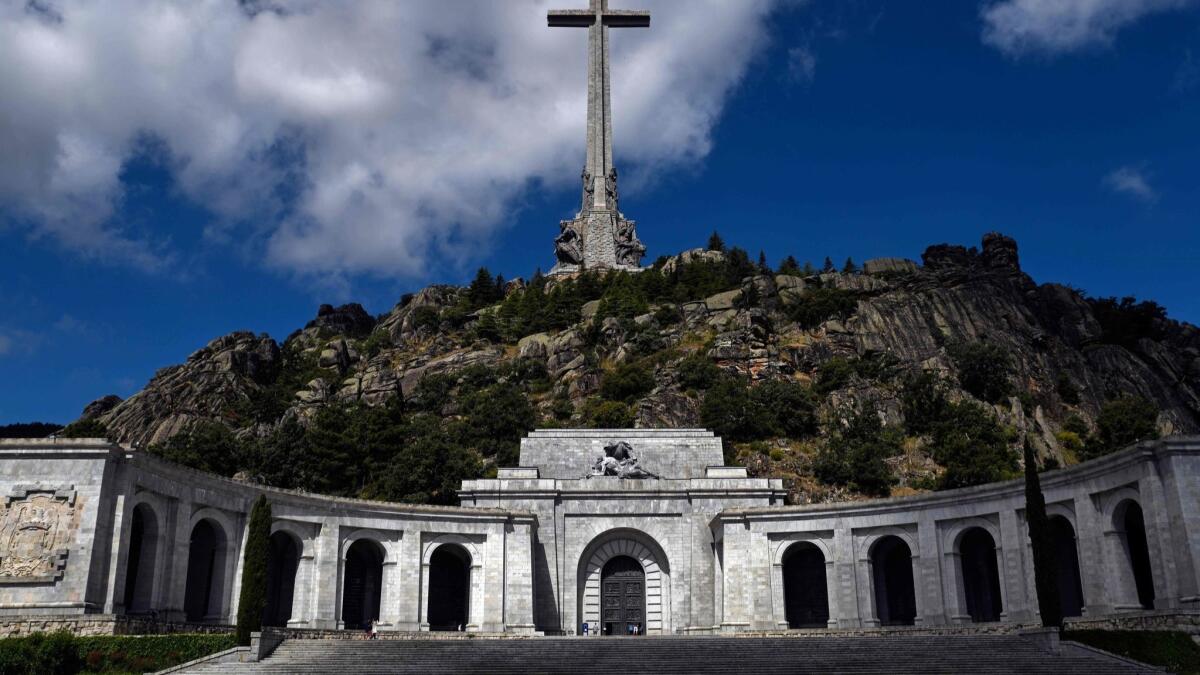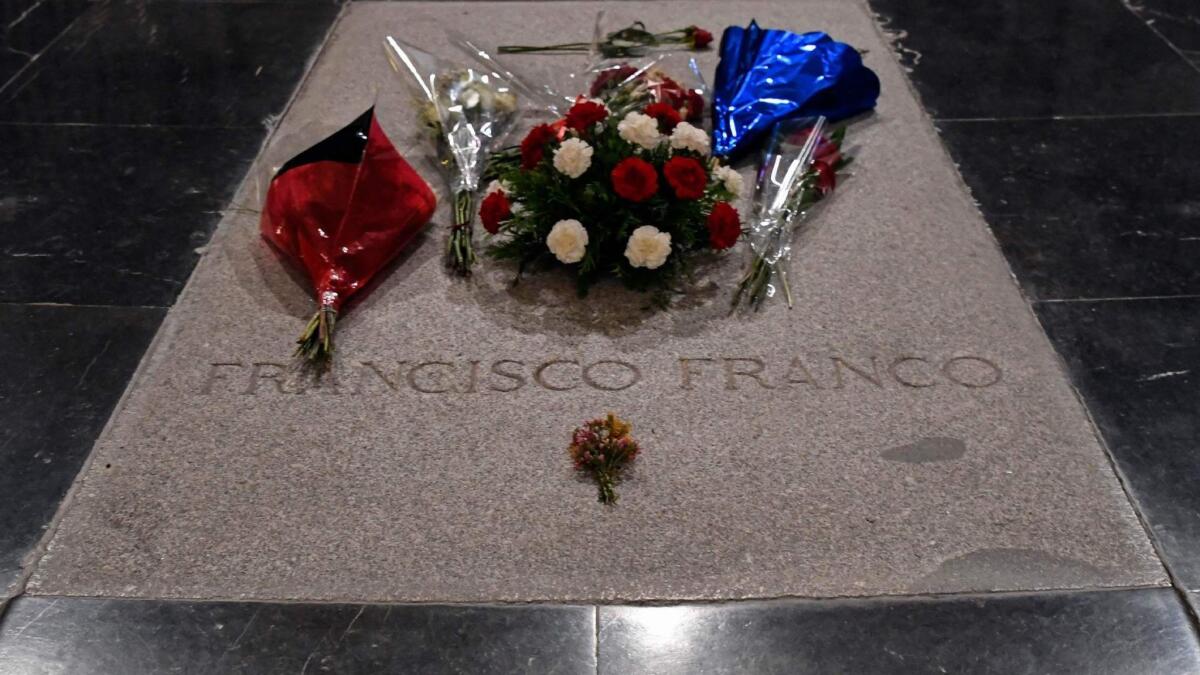Must Reads: Spain is still divided over the legacy of its former dictator. But will exhuming his body help the country heal?

- Share via
Reporting from VALLE DE LOS CAÍDOS, SPAIN — On a quiet morning at the foot of the imposing mausoleum where the remains of Spain’s former dictator Francisco Franco lie, a lone man lifted a red and yellow flag high above his head.
“Viva Franco!” shouted José María Martínez Fuego, 69, his booming voice echoing across the bright plaza as a crush of tourists took photos of the looming structure and the 500-foot-tall cross perched on the hill above.
Martínez Fuego visits the Valley of the Fallen, an austere basilica housing the unidentified remains of thousands of Spanish Civil War soldiers, two days a week with his dictatorship-era flag in tow. A former security guard for the “Caudillo,” as Franco supporters still call him, Martínez Fuego has spent the past several months protesting the expected exhumation of the dictator’s remains from the mausoleum built into the mountains 30 miles outside of Madrid.
“I am Spanish, I am with the Caudillo, I am a patriot, and I am not racist,” Martínez Fuego said, careful not to let his flag touch the ground. “You can’t move Franco from here.”
Last month, the Spanish parliament took a controversial vote to do just that — remove Franco’s remains from the Valley of the Fallen before the end of the year. The government sees it as a profoundly symbolic move aimed at helping a country divided over the dictator’s legacy come to terms with his regime more than 40 years after his death.

In arguing for the exhumation, Socialist Prime Minister Pedro Sanchez said that the mausoleum should be a site of reconciliation for Spaniards.
“No democracy can permit monuments associated with a dictatorship,” Sanchez said in a July speech to the Spanish congress. “Our democracy will have symbols that unify, not separate.”
But far from unifying Spaniards, the decision to unearth Franco’s remains has polarized the nation, a reaction that underscores a broader division in Spanish society about how to interpret the civil war and Franco’s 40-year reign.
After the civil war of 1936-39, Franco had the mausoleum built, in part using the forced labor of political prisoners, as a monument to his victory. Though he dedicated the monument to all those who died in the war, only two graves are marked: his, and that of José Antonio Primo de Rivera, founder of Falangism — the nationalist Catholic political ideology to which Franco subscribed.
The mausoleum also contains the bodies of at least 33,000 people who fought on both sides of the civil war, making the site one of Europe’s largest mass graves. Today, the Valley of the Fallen is a government-subsidized national heritage site that has hundreds of thousands of visitors a year.
Supporters applaud the expected exhumation as an important step in bringing justice to Franco’s victims. Opponents, though, say exhuming Franco would only reopen old wounds and amounts to erasing part of the country’s history. Some refuse to consider Franco a dictator.
Juan Chicharro, president of the National Francisco Franco foundation, which promotes a positive interpretation of Franco’s dictatorship, called the planned exhumation “an act of pure revenge and hate.”
“The left in Spain has spread indoctrination against Franco, based totally on lies,” Chicharro said. “No one thought it was strange Franco would be buried [in the Valley of the Fallen] in 1975.”
Pelái Pages i Blanch, a history professor at the University of Barcelona, said the remains of all individuals at the Valley of the Fallen should have been removed following the death of Franco in 1975, and the government then should have converted the site into a monument to memorialize the war and its victims.
“Historical memory is fundamental so things that happened in the past do not repeat later,” Pages said. “It is important not to forget the past.”
He added that the Spanish government should speak frankly about the dictatorship and condemn the interpretation that Franco was a benevolent leader.
“Double memory cannot exist,” Pages said.
The conflict over how to remember Franco’s regime has long defined Spanish politics. Two years after the death of Franco, a newly formed parliament passed an amnesty law that prevented members of the dictatorship from being tried in court. The “pact of forgetting” was aimed at facilitating a smooth transition to democracy — and would ensure government silence on the legacy of civil war for decades to come.
In 2007, the socialist government of José Luis Rodriguez Zapatero made the country’s first comprehensive attempt to grapple with that legacy, officially condemning the Francoist state and removing hundreds of Francoist symbols from buildings and public spaces around Spain. The law also stipulated that the state provide support for families wishing to unearth bodies of soldiers throughout Spain who went missing during the war.
While most dead soldiers who fought for Franco were exhumed, identified and memorialized after the civil war, thousands of soldiers for the losing side remain missing, 80 years later. Since 2000, regional governments and universities have exhumed more than 300 mass graves containing the bodies of civilians and Republican soldiers.
But Zapatero’s successor, the conservative Popular Party Prime Minister Mariano Rajoy, stripped the law of state funding, complicating efforts to exhume mass graves.
The lack of government support has left researchers struggling for the funding necessary to perform exhumations.
Sitting in his office at the Universitat Rovira i Virgili, in the southern Catalonia city of Tarragona, Josep Sanchez Cervello looked over a human femur he keeps in a filing cabinet near his desk. Sanchez, a historian, is overseeing two exhumations currently underway in the Ebro River region of Catalonia, where the bloodiest battle of the civil war took place.
Sanchez said that after the war, “there was never any interest on the part of the winners to reconcile with the losers,” resulting in decades of silence. And though Spanish people now speak openly about the dictatorship, the ongoing effort to exhume bodies has slowed because of funding and a lack of attention.
“I am so tired of finding dead bodies,” Sanchez said with a sigh, adding that one day he hopes he will no longer need to perform exhumations because everyone will have been found.
Activists have also called for the exhumation and identification of soldiers from the Valley of the Fallen, a complicated task that would require DNA tests on thousands of bodies. But at present, Pages said, the Valley of the Fallen functions only as a “Franco pilgrimage site.”
To that end, fresh flowers are placed on Franco’s and Rivera’s tombs each day. On a Friday last month, 13 bouquets and one red rose lay on Franco’s tomb.
As Martínez Fuego, the former security guard for Franco, shouted on the plaza outside of the mausoleum, several people asked to take photos with his flag. One woman shook his hand and said firmly, “Long live our flag.”
Miguel Ángel Trejo Sardoa, 66, admired the basilica with a group of friends after attending the morning Mass, held daily.
“The people who want Franco exhumed are resentful, they want to win the war 80 years later,” he said. “It’s our history and we have to respect history. There were people shot on both sides of the war. And we have to respect the memory of the Caudillo.”
Some visitors cautiously expressed support for the exhumation.
Patric Tato, 49, an artist who visited the Valley of the Fallen to film a documentary project, said the “immense and sublime” monument should become a museum explaining Franco and Falangism.
“There is no explanation here,” he said, lamenting the lack of plaques or signs to provide context. “We need to explain what this is. Fascism, Catholicism, the role of the church.”
He glanced up at the towering cross, so tall and austere it is visible from the highway that snakes through the foothills below.
“Tourists often have no idea what this site is,” Tato said. “And later, they realize, it memorializes a dictator.”
Bernhard is a Times special correspondent.
More to Read
Sign up for Essential California
The most important California stories and recommendations in your inbox every morning.
You may occasionally receive promotional content from the Los Angeles Times.










